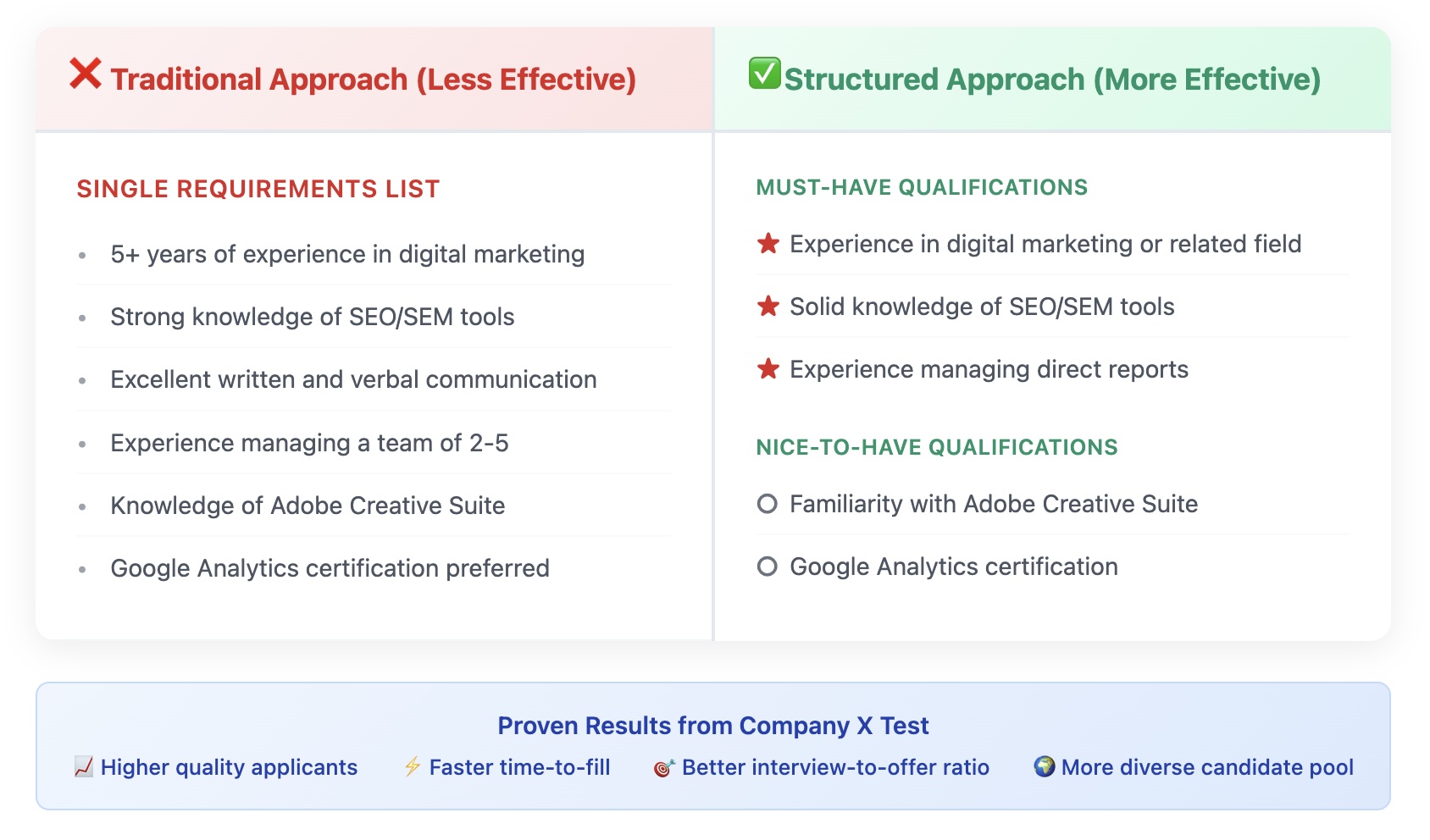More companies are committing to skills-based hiring these days — for good reason. By focusing on skills when evaluating job candidates, employers are opening doors to individuals from historically marginalized groups who may not have had the chance to go to college. At the same time, as companies face serious skills shortages, skills-based hiring is helping them widen the talent pool.
In fact, 73% of hiring pros say hiring based on skills is a priority, according to LinkedIn’s Future of Recruiting 2024 report. A growing number of employers are taking the first step of dropping degree requirements from their job posts, with the number of jobs listed on the LinkedIn platform that omit degree requirements jumping 36% between 2019 and 2022.
But while companies are committed to skills-based hiring, results have been slow so far. A recent study by the Burning Glass Institute and Harvard Business School found among big organizations that removed college degrees as prerequisites, the share of those jobs that went to nongraduates, after at least one year, grew by just 3.5%. Employers may be advertising that they’re open to hiring people without degrees, but in the end, researchers found, most aren’t following through.
The study underscores the fact that skills-based hiring is a major undertaking that requires culture change and multiple steps beyond dropping degree requirements. “This involves an entire end-to-end solution and ecosystem that we have to be thoughtful about,” says Lorraine Stomski, chief talent officer at Walmart, which has been at the forefront of the skills-based hiring movement.
What should you be doing if you want to make real progress advancing skills-based hiring? Read on.
1. Enlist the support of company leaders and hiring managers
For years, the four-year degree has been the gold standard for evaluating candidates. To change that mindset, you’ll have to convince company leaders and hiring managers that the business will benefit from hiring candidates based on their skills.
“You have to have business buy-in,” says Gregory Karanastasis, global head of talent acquisition, onboarding, and career transitions at Accenture, where the majority of jobs no longer require degrees. “You have to sell the benefits.”
One way to build a business case for skills-based hiring is by measuring the impact it’s having on your organization. Think about the goals that are relevant to your company and track progress, advises Elyse Rosenblum, managing partner of Grads of Life, a nonprofit that advises employers on skills-based talent strategies. Has dropping degree requirements boosted employee retention and engagement? What about your bottom line? Are you doing a better job meeting your diversity goals? It’s also worth asking: Have you cut your time-to-hire?
Hiring managers bear much of the risk of bad hiring decisions and some might need to be convinced that skills-based hiring will help them achieve better, faster hires. By sharing data and success stories, you can start to overcome resistance. LinkedIn research, for instance, shows employees without four-year degrees tend to stay 34% longer than workers with degrees.
Walmart uses skill assessments to help store managers vet candidates during the hiring process. Workers who test highly on the skills deemed important for success in the role will have that noted in green on their report — indicating that they’re a good fit for the role.
“We know that if we hire the ‘greens,’” Lorraine says, “it increases engagement in the store, it increases our customer NPS (customer loyalty and satisfaction) scores, and we have higher KPIs (key performance indicators) in those stores.”
2. Identify the roles you want to focus on
Think about job categories within your organization where demand for talent is high and filling open positions is especially challenging. What areas of your company will most benefit from skills-based hiring?
“Find the department that is struggling with turnover, struggling with fill rates,” says Michelle Sims, CEO of YUPRO Placement, a mission-driven, skills-based staffing firm that matches skilled job seekers who may not have four-year degrees with professional roles. “Then, you can really dial in.”
In addition, focus your efforts on places within your company where skills-based hiring is likely to be embraced by hiring managers and less likely to face roadblocks. “Focus first,” Elyse says, “on areas where you’ve got strong internal champions.”
3. Match skills to roles
It’s a given that to successfully hire based on skills, you’ll need a clear grasp of the skills necessary to do the job. But how do you get there? Some organizations are creating skills taxonomies, which categorize and classify the skills relevant to jobs. With a detailed taxonomy in place, you can create more accurate job descriptions.
Matching skills to roles can be complex and time-consuming, and you might want to seek outside help. Grads of Life, for instance, advises companies on how to rewrite job descriptions with the appropriate competency requirements.
Advances in AI are expected to make the process of rewriting job descriptions easier over time. “Over the next couple of years,” Elyse says, “we’re going to see AI really be a force for good in making this go much faster and much easier.”
4. Give recruiters the right screening tools
As skills become more important, recruiters will need a new framework for evaluating candidates. Companies should determine the evaluation methods that make the most sense for them. Those might include skills assessments and problem-solving exercises.
Software company SEP wants to ensure that its hires have the appropriate soft skills, as well as hard skills, to succeed. The company works with Woven, a tech interview platform, to assess such things as candidates’ ability to communicate well with teammates. “Figuring out how to test for those other things is vital,” says Kyle Pinches, SEP’s director of talent acquisition and onboarding.
Create a structured interview process that will help recruiters focus on evaluating candidates’ skills and minimize the chance that recruiters’ biases will influence their decisions. Each candidate should be asked the same questions, in the same order, to ensure they’re all being evaluated based on the same criteria. “Build questions based on skills,” Michelle says, “and make sure that everyone in the process is doing the same thing.”
5. Find your “STARs”
Seek out workers who’ve been “skilled through alternative routes,” or STARs, a name coined by the nonprofit organization Opportunity@Work, a leading skills-based hiring advocate.
STARs are individuals who do not hold four-year degrees but have picked up essential skills through alternative means, such as boot camps, on-the-job training, community colleges, or military service. Organizations such as YUPRO Placement, as well as government and nonprofit workforce development organizations, can help you connect to this critical talent pool.
SEP encourages its current employees to attend local tech meetups where they might meet people who gained software development skills through nontraditional paths, Kyle says. In some cases, these casual meetings have led to hires.
Some employers are creating alternative talent pipelines of their own. They’re upskilling prospective workers to prepare them for jobs and they’re offering on-the-job training and internal mobility programs to their current employees.
United Airlines, for instance, is focusing on career development in three job categories, pilots, aircraft technicians, and digital technologists, the company’s chief diversity equity and inclusion officer, Jessica Muench, explained during a LinkedIn roundtable discussion.
“We’re building our own pipelines,” Jessica said, “in three key areas where we don’t right now see the talent or diversity in the marketplace that we want within our organization.”
One of United’s programs, called Innovate, is a full-time, paid apprenticeship offering two years of on-the-job training for careers in tech. After finishing the program, participants are placed in analyst-level roles, based on their experience and availability. The program is open to United employees as well as nonemployees.
“We have a lot of confidence that folks will stick with us,” Jessica said, “because we’ve invested in them and they’ve invested in themselves.”
Final thoughts
For employers that want to move forward on skills-based hiring, there are organizations offering advice and resources. Grads of Life, for instance, has a variety of tools for employers including an Opportunity Identifier that captures a company’s current practices and identifies appropriate actions. Another nonprofit, Jobs for the Future, has skills-based hiring toolkits with instructions on such things as writing job descriptions and conducting effective interviews.
“There’s a road map,” Elyse says. “There are organizations like Grads of Life that are here to support you if you want to get started and feel overwhelmed. I encourage everyone to step in. This is a movement whose time has come.”











